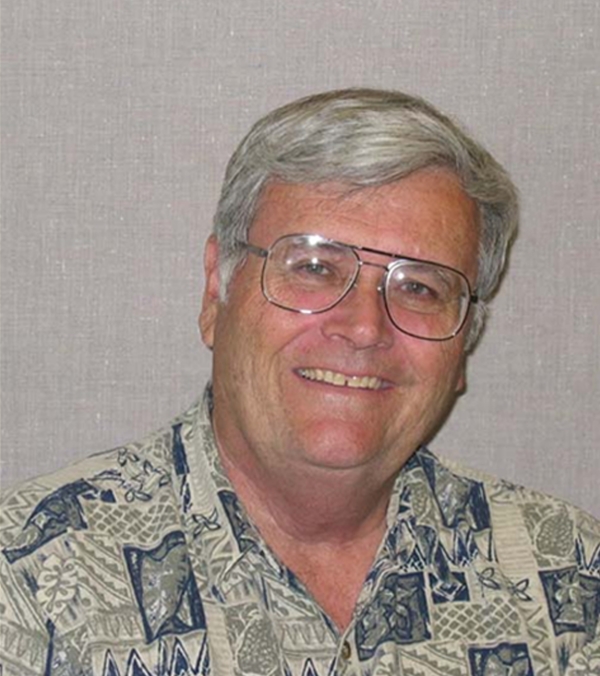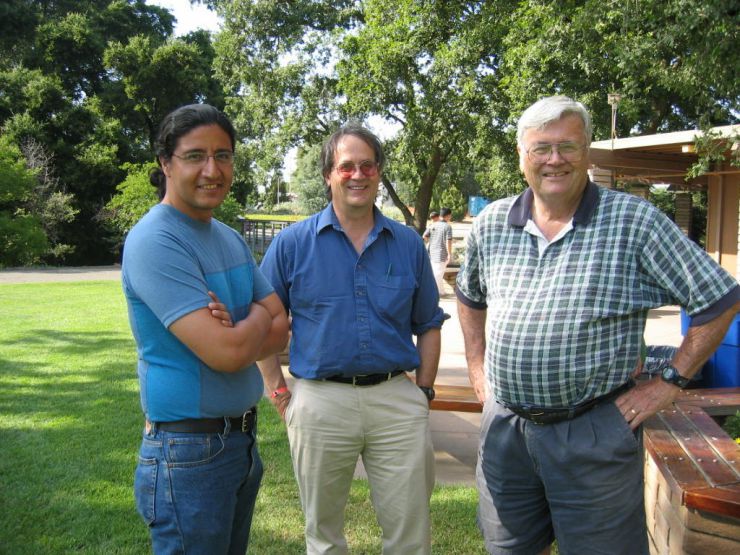
Thomas Cahill, professor emeritus of physics and atmospheric sciences, died from complications of cancer on May 1, 2019. He was 82.
Thomas A. Cahill earned a B.A. in physics from Holy Cross College, Worcester, MA, a M.A. in physics from UCLA in 1961, and a Ph.D. in physics from UCLA in 1965. Over his career, spanning more than five decades, Professor Cahill made important contributions to research in the field of atmospheric optics, with funding from the National Science Foundation, Environmental Protection Agency, American Lung Association, and others. In his nomination of Tom for a Distinguished Public Service Award in 1994, former Chair of Physics Barry Klein wrote: "Professor Tom Cahill has made numerous, major contributions to both the scientific and the public infrastructure regarding environmental issues, especially those related to air pollution. ...Tom Cahill has brought great credit to UC Davis." Tom retired from active service in 1994, though he continued, with vigor and enthusiasm, to impact the field of air quality and global climate research for the next 30 years.
The College of Letters and Science obituary: https://lettersandscience.ucdavis.edu/news/memoria...

Personal Stories
John R. Smith and Tom Cahill
When I first came to UC Davis in 1975 my very first TA-ship was with Tom Cahill who was teaching Physics 116 -- which was Electronics. I was his lab assistant and had memorable students in that class including Kaori Maeshima and also Barry Schwartz -- I got along fabulously with Tom and really enjoyed the technical detail he put into the textbook which he had written for the class. It was chuck full of applications of Laplace Transforms and the emphasis was on applications to signal circuits and used Laplace Transforms to analyze transients and other critical aspects of signal transmission. I learned a lot from Tom and really liked my first TA-ship.
Also, my second and third year roommate, Bruce Kusko, became one of Tom's graduate students and worked on the Gutenberg Bible in the Louvre in Paris with Tom's group -- the group used the Crocker Lab to analyze not only air samples, but the ink from the Gutenberg Bible and this work continued using a accelerator in the Louvre in which Bruce was a principal researcher from UC Davis.
I have many fond memories of Tom -- he was a link between my Alma-Mater (the University of San Francisco) and UC Davis -- when I came to UCD in 1975 there were other graduate students in the physics department who all came from USF due to Tom Cahill's encouragement and advocacy for UCD. Joe Erwin was one of the graduate students who came from USF to UCD before me -- and Tom Cahill was responsible for the good relationship between the physics department at USF and UCD and one of the people encouraging physics majors from USF to continue graduate school in physics at UCD.
I also knew Tom Cahill from St. James Parish -- where he attended Mass.
-John R. Smith
Eric Prebys and Tom Cahill
This is such a shock. He came into Crocker a couple of weeks ago. He was weak, but when he talked, you wouldn't know anything was wrong. We talked about the future. He still had lots of plans. He accepted that it was just a matter of time, but we all thought it would be at least a little more time. I didn't have much time to get to know Tom, but I still feel like a piece of me has been lost.
-Eric Prebys
Barry Klein and Tom Cahill
Tom (and Ginny) was one of the "old timers" who were very welcoming to me when I joined the department 1992. I am very grateful to them and will always remember Tom's upbeat, full-of-life demeaner.
I also remember some great visits to his family property along Putah Creek in the hills near Monticello Dam. He had quite a full and impactful life.
-Barry Klein
Thomas Weideman and Tom Cahill
I am very saddened to hear of Tom Cahill's passing, and my deepest condolences go out to his family. I have known Tom for close to 35 years, since my days as a graduate student at UCD. I personally have always thought of him as the best of us - the consummate physicist. This man had not only unparalleled acumen in his field, but absolutely unbridled energy and enthusiasm to pursue whatever most interested him. Fortunately for all of us, many of his interests happened to lie along directions that benefitted society at large, and he was unyielding in his pursuit of the truth and the social change it stimulated. I have two specific stories I would like to share about Tom, one that is personal, and another that perhaps several others will remember.
While I had known about Tom by reputation for his work on the Gutenberg bibles and the Dead Sea Scrolls (which received a lot of press then), my first personal encounter with him was as a committee member for my oral qualifying exam. Unsurprisingly, he asked me a question that stumped me: "If you 'turned off' each of the 4 fundamental forces one by one, roughly how long would it take to realize anything was different?" It seemed to me that we should know about all of them right away, but that belied the fact that he was asking the question, so I fumbled around for a little while trying to figure out where he was going. He then mercifully explained that everything except the weak nuclear force would be noticed immediately. The weak force, by contrast would take about 8 minutes, which is the time needed to see the effects it has on the workings of our sun. The exact details of the physics aside (i.e. what does it means to "turn off" a force anyway, and depending on the answer, the effects may cascade throughout more immediately-noticeable realms), this idea nevertheless gives insight into Tom's penchant for bringing somewhat esoteric ideas into our everyday experience.
In March of 1989 a major announcement shook the academic scientific world: Pons and Fleischmann announced that they had managed to produce a net gain of energy through "cold fusion," using the electrolysis of heavy water with palladium. My recollection is that at most a couple days later, Tom (and others) were giving a talk on this topic in Roessler 66. Well before this talk, Tom noticed a number of problems with the experimental setup. I can't recall the exact litany of problems, but one of them had something to do with neutron counts, and how one of the electronic devices employed for some other part of the experiment was positioned (as shown in a photo of the apparatus!) such that it would register counts in the Geiger counter, introducing error into the analysis. So Tom immediately thought the results smelled fishy, and it took very little time for his meticulous experimenter's mind to pinpoint several problems and report them to all of us.
Whenever I heard Tom was going to give a talk, a never missed the opportunity to attend (his most recent not being that long ago). The information he passed along was always highly eye-opening, and his upbeat take on the good things physicists can do for society never failed to inspire me. I selfishly feel an enormous loss in the knowledge that I will never again have the opportunity to receive one of these pep talks.
-Thomas Weideman
Kai Liu and Tom Cahill
Tom was an inspirational figure to me, as a scientist and a philanthropist.
When I first met Tom in the early 2000's, he was enjoying a second distinguished career in environmental science, having already retired from Physics. I didn't think that was possible. He was in a league of his own.
My more direct interaction with him was through the generous gift he and Ginny made to the department. That prompted us to think about using certain nanomaterials we developed for condensed matter experiments towards environmental physics explorations. Tom's enthusiasm, wisdom, and support were absolutely critical in the early stages of our project. We continue to work on this today, and hope to make further progress that will make him proud.
-Kai Liu
Larry Coleman and Tom Cahill
Diana and I are truly saddened by Tom's passing. He was one of best.
Tom welcomed me to the department in 1976 and was ALWAYS a stellar colleague. The department, UC Davis and the World will be a lessor place without Tom. We should be comforted by the knowledge that Tom will live in our hearts and never truly be gone!
-Larry Coleman
Lloyd Knox and Tom Cahill
I also saw Tom on Sunday at his house. He was just as Warren described. He was enthusiastic about the ways in which his legacy would be continued and expressed his gratitude for the work I have done with students in the project-based course that he and Ginny supported. Beyond enthusiasm, you could say he was full of joy and gratitude. He started telling me about the low-cost drum sampler for air pollution studies. I told him I heard about it from Eric Prebys. He said, "That's the right guy to hear about it from!"
I was seeing him less than a week after I lost my mother. Ginny and their children were very sweet with me about that. Cathy hugged me and said to stop by any time if I wanted someone to cry with.
Quite an amazing man, and extraordinary family. I am very sorry we will not have him come speak to our students again in the Alumni Seminar Series. But his daughter, who has a degree in physics, will come next spring.
-Lloyd Knox
Ching Fong and Tom Cahill
I feel sorry that I did not know that Tom was sick because he was energetic, happy, and optimistic. He was a dedicated physicist. His devotion to analyze the pollutant in Arizona was really impressed me. Tom is remembered by many of us.
-Ching Fong
Daniel Cox and Tom Cahill
Tom will be missed. I think of his happily skeptical and curious spirit, his inventive application of nuclear physics to environmental problems, his bold and important monitoring of the air around the World Trade Center after 9/11, and his generous legacy to the department.
RIP to a wonderful scientist, human being, and colleague.
-Daniel Cox

